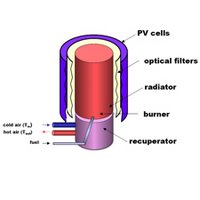More on Thermoelectrics: Thermophotovoltaics

Last week I posted on Rennselaer's active building envelope technology, utilising thin-film thermoelectric heat pumping combined with thin film photovoltaics. The ABE technology could effectively replace conventional heating and air conditioning systems, and provide electricity to the building at the same time.
Researchers at MIT are working on a novel form of thermoelectric technology for use in automobiles. Called thermophotovoltaics, it involves using heat to generate light at specific wavelengths, which is then used to generate electricity with photovoltaics. Multiple energy conversions are involved--from chemical to heat to light to electricity--which risks introducing inefficiencies into the process. Regardless, it is quite clever, and may eventually find an economical fit in tomorrow's automobiles, in replacing mechanical devices such as alternators and compressors.
According to Kassakian, the system could potentially be a more efficient way to power electrical systems in a vehicle than the current alternator-based one, which wastes energy in two stages: the internal combustion engine converts only about 30 percent of the energy in fuel into movement, and then the alternator is only 50 percent efficient in converting the mechanical energy into electricity. He says a small prototype thermophotovoltaics device that could confirm the system's improved efficiency might be ready in a year.Source.
The researchers modified the surface structure of the light emitter, etching into it nano-sized pits to tune the wavelengths of light emitted to precisely those a photovoltaic cell can convert most efficiently into electricity. They further refined the device with the use of filters that allow the desired wavelengths of light to pass through to the photovoltaic cells, but reflect other wavelengths back to the light emitter. The reflected light carries energy that helps keep the emitter hot, reducing the amount of fuel needed.
In addition to replacing the alternator with a thermophotovoltaic module, says Kassakian, the technology could be part of an air-conditioning system for vehicles that doesn't require a compressor. Because this would significantly decrease the load on an engine, it could make it possible to turn off the engine when the vehicle stops in traffic and easily restart it.
Labels: photovoltaics, PV

0 Comments:
Post a Comment
Subscribe to Post Comments [Atom]
<< Home